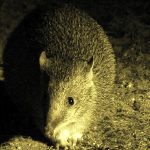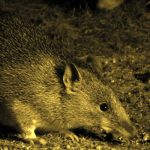WESTERN BARRED BANDICOOT
The Western Barred Bandicoot – A Nocturnal Gardener of the Outback
The Western barred bandicoot is a small but remarkable marsupial, roughly the size of a rabbit, yet brimming with character and ecological importance. By day, it remains hidden from view, resting in a shallow nest of dried vegetation tucked beneath shrubs or grass tussocks. But as night falls, it emerges — a shy, quick-footed shadow with a delicate, pointed snout and large, keen ears that swivel at the faintest sound. Its soft, mottled brown fur is patterned with pale bars across the rump, a natural camouflage that blends effortlessly into the sandy dunes and shrublands of its home.
Life on the Islands
Today, the Western barred bandicoot survives in only a fraction of its former range. Once found across much of southern Australia, it now clings to existence on a handful of predator-free islands, including Bernier and Dorre Islands off the coast of Western Australia, with additional populations established on conservation‑managed islands (such as Faure) and within fenced sanctuaries.
Some reintroductions have faced setbacks from feral cat incursions or disease, underscoring the need for ongoing predator control and biosecurity.
These remote sanctuaries, with their wind-sculpted dunes, coastal heathlands and saltbush flats, provide the perfect refuge from foxes, cats, and other threats.
By night, the cool sea air carries the scent of salt and vegetation, and the sand beneath the bandicoot’s paws shifts softly as it forages. Every movement is calculated — a quiet hop here, a sudden pause there — ears pricked for danger.
A Forager with Purpose
The Western barred bandicoot is a generalist feeder, enjoying a varied menu that includes insects, larvae, seeds, roots, and fungi. It uses its sensitive nose to detect hidden food, then digs with sharp foreclaws to unearth its prize. This seemingly simple act of digging serves a much larger purpose: it turns over the soil, helps rainwater soak deeper into the earth, and assists in the dispersal of seeds and spores. In this way, the bandicoot acts as an “ecological engineer”, quietly maintaining the health and balance of its environment.
Life Cycle and Family
Breeding can occur throughout the year, a rare advantage in the animal world. After an exceptionally short gestation of about 12 days — one of the shortest among mammals — the tiny, underdeveloped young crawl into their mother’s pouch, where they continue to grow for several weeks. Even after leaving the pouch, they remain close to their mother, learning the art of foraging and survival.
In the wild, most Western barred bandicoots live for three to five years, a brief life filled with constant challenges. Despite their resilience, their survival depends heavily on the safety of their fragile island habitats.
Sounds of the Night
If you were to stand quietly among the low shrubs on a still night, you might hear the faint rustle of dry leaves, the gentle patter of small feet on sand, or a soft thump as a bandicoot hops away. Their calls are subtle — quiet grunts and squeaks — but they carry meaning in the darkness, a way to communicate with mates or young.
Conservation – Protecting the Night Gardener
The Western barred bandicoot is officially listed as Vulnerable, though its situation remains precarious. Conservation programs focus on predator control, habitat restoration, and the establishment of safe, fenced mainland reserves. These efforts are vital, not only for the bandicoot but for the ecosystems it supports.
How you can help
- Support organisations restoring arid‑zone mammals and managing safe havens in Shark Bay and beyond.
- If visiting islands or sanctuaries, follow biosecurity rules: clean gear, check bags and vehicles for seeds and stowaways, and never take pets.
- Advocate for responsible cat ownership and support feral predator control programs.
- Back research and ranger programs that combine science with Traditional Owner land stewardship.
When we keep the night quiet of predators, the shrubs thick with shelter, and the sands free of hidden threats, the Western Barred Bandicoot resumes its moonlit search for insects and seeds. Protecting this small, soft‑footed digger restores a whole web of life — healthier soils, thriving plants, and the living memory of Australia’s desert mammals.
This little marsupial is a reminder that even the smallest creatures can shape the land in profound ways. By protecting the Western barred bandicoot, we safeguard a living link to Australia’s natural heritage — a gardener of the night whose quiet work benefits us all.



